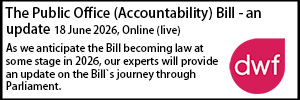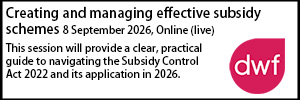Social Impact Bond schemes
- Details
 Craig Elder examines the opportunities provided by social impact bonds - and how to overcome the barriers to their successful implementation.
Craig Elder examines the opportunities provided by social impact bonds - and how to overcome the barriers to their successful implementation.
Social Impact Bond (SIB) schemes are a relatively new concept, with only a small percentage of public services delivered under them. However, over recent years there has been a steady increase in the number of schemes emerging as public authorities strive to find alternative delivery models. Will SIB’s go on to play a more prominent role in public services?
What is a social impact bond scheme?
The aim of a SIB scheme is to tackle entrenched social issues such as drug and alcohol dependency, homelessness and recidivism.
Under a SIB, a commissioner contracts with a delivery partner who will seek to address the relevant issue. These interventions will be funded by a social investor, whose return is based on delivery of measurable outcomes (this is known as a payment by results model).
SIBs in action
This year, a number of projects were announced as receiving investment from the Life Chances Fund which was originally launched in 2016 to support SIB projects. A few examples of these projects are:
- Norfolk County Council: A project to reduce the number of days children and young people spend in care. Striving to achieve improvements to the children’s school attendance, educational attainment and wellbeing.
- Gloucestershire Positive Behavioural Support Service: A project which aims to avoid the poor outcomes and high costs associated with children and young people with learning disabilities in residential care settings.
- The Skill Mill: A project to help get ex-offenders aged 16 - 18 into paid labour opportunities.
- Family Lives, Westminster and Kensington & Chelsea: A project to help narrow the gap in school readiness between vulnerable children and their better off peers by introducing the Parent Child Home Program, an American evidence-based programme targeted at low income and vulnerable families.
Other examples of established SIBs are Thames Reach, a personalised service pathway for a cohort of 415 rough sleepers and Shared Lives which is a programme which promotes an alternative to care homes for people in need of substantial support in which carers share their lives and sometimes living accommodation with those they support (programmes currently being run in Lambeth, Manchester, Haringey and Thurrock).
According to Social Finance there are currently nearly 100 Social Impact Bonds globally mobilising more than £300m of investment.
What are the benefits to public sector commissioner?
- The programmes are likely to adopt innovative approaches which would have been too risky without funding from an investor. This means the local community benefits from services and projects that it would not otherwise have access to. Since commissioners usually do not have to make payment until the outcomes have been achieved, there is more scope to try out something new which a commissioner or provider could not typically afford.
- The nature of a payment by results contract means that the focus is on the outcome not the output, so service providers are able to take a more proactive approach to adapting support to service users as and when it is required.
- SIBs present opportunities for better contract management through fostering a culture of monitoring and evaluation. Because SIBs are outcome focused, they force service providers to collect and manage key data related to their target audience.
- Linking payments to outcomes should lead to an interest from all parties on improving delivery, which in turn can achieve better outcomes and financial returns.
What are the barriers to launching a successful SIB?
- Defining appropriate outcome metrics which accurately reflect improvement for service users can be difficult. Public authorities need to strike a balance between setting outcomes that if, achieved, will have real social value but, on the other hand, not be so ambitious that it is difficult to secure social finance.
- SIBs are complex to design and manage, and can take a significant period of time to set up. If there is an urgent need for a service then this initial time investment might become a barrier to adopting this approach.
- Pursuing a SIB approach does not allow a public authority to sidestep any of its normal statutory obligations when purchasing services such as fulfilment of consultation requirements, compliance with procurement rules and achieving best consideration for any public assets that are used in the service. It is important to involve procurement and contracting experts from the beginning, allowing time to consider how essential rules and regulations can work in a SIB context.
- SIBs are not appropriate for every project. In particular, studies have shown that SIBs are more successful when they involve long term goals, allowing for interventions to become established and for outcome metrics to develop. Furthermore, SBIs are often more effective when projects are delivered on a larger scale (typically £1 million or more) so as to justify transaction costs. However, if SIB’s become more common, there should be opportunities to increase standardisation and, therefore, decrease set-up costs.
- Whether SIBs, or other payment by results models, will form a significant part of public services remains to be seen. However, it is an approach which hard-pressed commissioners may increasingly wish to consider as part of the mix of solutions available to them.
Craig Elder is a partner at Browne Jacobson. The firm has advised on a number of these arrangements and, if you would like to discuss any issues around SIBs, or similar payment by results approaches, contact him on 0115 976 6089 or
Sponsored articles
Unlocking legal talent
Walker Morris supports Tower Hamlets Council in first known Remediation Contribution Order application issued by local authority
Contracts Lawyer
Legal Director - Government and Public Sector
Lawyer (Planning and Regulatory)
Locums
Poll
15-07-2026 11:00 am














































